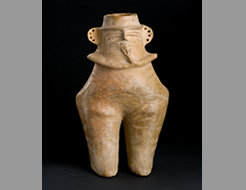|
|||||||||||||||||||||||||||||
|
|
Museum of: Bucharest | ||||||||||||||||||||||||||||
| Name of the artefact: The Goddess of Sultana | |||||||||||||||||||||||||||||
|
The artefact represents a vessel made of burnt
grey-yellowish clay, modelled in the shape of the human body |
|||||||||||||||||||||||||||||
|
WHERE IS IT AND MAIN CHARACTERISTICS |
STATE |
||||||||||||||||||||||||||||
|
Department: |
Archaeology |
Preservation: |
Good | ||||||||||||||||||||||||||
|
Inventory number: |
102326 |
Restauration: |
Restored | ||||||||||||||||||||||||||
|
Name of the artefact: |
The Goddess of Sultana |
Completeness: |
Almost Complete | ||||||||||||||||||||||||||
|
Object type: |
Human figurine |
||||||||||||||||||||||||||||
|
Material: |
Clay |
||||||||||||||||||||||||||||
|
Methof of manufacture: |
Shaping, firing |
||||||||||||||||||||||||||||
|
Decoration type: |
Painting |
||||||||||||||||||||||||||||
|
Distinctive mark: |
- |
||||||||||||||||||||||||||||
|
DIMENSIONS |
PERIOD OF USE |
||||||||||||||||||||||||||||
|
Length (mm): |
- |
Epoque: |
Neolithic |
||||||||||||||||||||||||||
|
Heigth
(mm): |
230 |
Culture: |
Gumelniţa |
||||||||||||||||||||||||||
|
Diameter
(mm): |
- |
Period: |
Eneolithic |
||||||||||||||||||||||||||
|
Width (mm): |
- |
Face: |
A2 |
||||||||||||||||||||||||||
|
Thickness (mm): |
- |
Absolute chronology: |
4500-4000 BC |
||||||||||||||||||||||||||
|
Weight
(g): |
- |
||||||||||||||||||||||||||||
DISCOVERY |
|||||||||||||||||||||||||||||
|
Date: |
1960 |
Country: |
Romania |
||||||||||||||||||||||||||
|
District: |
Călăraşi |
Town hall affiliation: |
Mănăstirea |
||||||||||||||||||||||||||
|
Village: |
Sultana |
Discovery findspot: |
Malu-Roşu |
||||||||||||||||||||||||||
|
Condition of discovery: |
Chance Discovery |
Discovery type: |
Deposit |
||||||||||||||||||||||||||
|
ANALYSES DETERMINATIONS |
FILLED IN BY |
||||||||||||||||||||||||||||
|
Type: |
- |
Name: |
Radian Andreescu, Katia Moldoveanu |
||||||||||||||||||||||||||
|
Laboratory: |
- |
Institution: |
Romanian History National Museum |
||||||||||||||||||||||||||
|
No./Code: |
- |
Date: |
23/02/2005 |
||||||||||||||||||||||||||
|
DEEPENINGS |
|||||||||||||||||||||||||||||
|
Morphology of the object: |
|||||||||||||||||||||||||||||
|
The vessel, known as The Goddess of Sultana, is
modelled in a human shape. The facial features are under the rime. The
eyes are marked by incisions with eyebrows in relief; the mouth is
depicted by a large incision with a range of holes into lip and the nose
is pointed. The big ears are perforated. The legs are short and thick. A
special attention is devoted to the buttocks and the hips, which are
emphasized. The schematic arms are modelled in an interesting position:
the right arm holds the left one which reaching toward the chin,
suggesting a person who is thinking. |
|||||||||||||||||||||||||||||
|
Decoration: |
|||||||||||||||||||||||||||||
|
The artefact, made of grey-yellowish clay is decorated
with geometrical motifs painted with white colour. |
|||||||||||||||||||||||||||||
|
Inscription: |
|||||||||||||||||||||||||||||
|
- |
|||||||||||||||||||||||||||||
|
Analogies: |
|||||||||||||||||||||||||||||
|
The vessels modelled in the human shape are wide spread
in Neolithic. They have different sizes and represent mostly feminine
personages, some of them made in a realistic manner. The facial details
are usually represented under the vessels rim, more rarely being
modelled on a lid attached to the vessel. The arms are modelled either
on the belly or represented like little handles. Usually these artefacts
have a painted or incised sophisticated decoration. Analogies: Vidra,
Sultana (Romania), Stara-Zagora, Gabarevo (Bulgary). |
|||||||||||||||||||||||||||||
|
Interpretation: |
|||||||||||||||||||||||||||||
|
The anthropomorphic vessel modelled in human shape has
obviously an attitude of meditation; this attitude could be linked to a
religious, spiritual reason. Such vessels were probably used during
religious rituals linked with the human community life. The decoration
can be interpreted as clothes or as a tattoo. Another interpretation is
that in her left hand she is holding panpipes suggesting that the
goddess was also a musician. |
|||||||||||||||||||||||||||||
|
Bibliography: |
|||||||||||||||||||||||||||||
|
Author: Marinescu-Bīlcu, S; Ionescu, B Title: Catalogul
sculpturilor eneolitice din Muzeul Raional Olteniţa Place: Sibiu Year:
1967 2. Author: Gimbutas, Marija Title: The Gods and Goddesses of Old
Europe Place: London Year: 1974 3. Author: Dumitrescu, Vl Title: Arta
preistorică īn Romānia Place: Bucureşti Year: 1974 4. Author: Gimbutas,
Marija Title: The language of the Goddess Place: San Francisco Year:
1989 5. Author: Andreescu, R 2002 Title: Plastica antropomorfă
gumelniţeană. Analiză primară Place: Bucureşti Year: 2002 |
|||||||||||||||||||||||||||||

